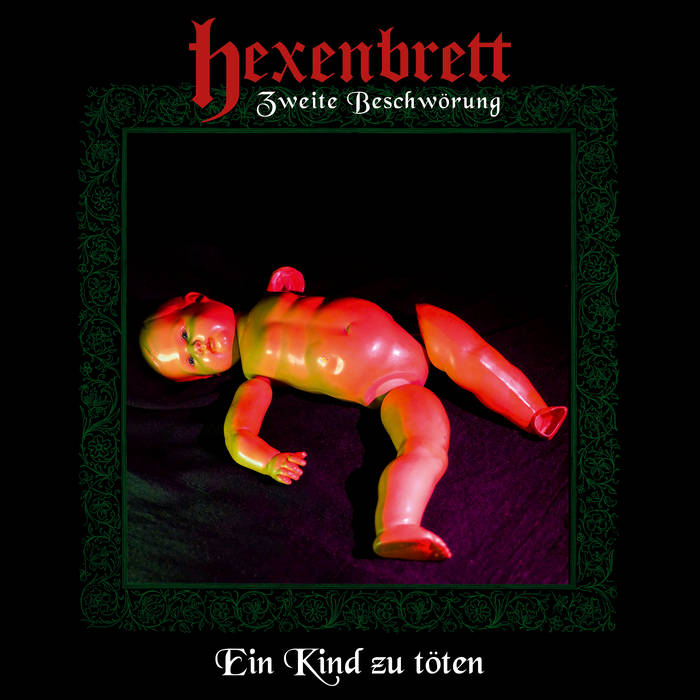Works its magic - 83%
The anonymity of Hexenbrett doesn’t leave much to talk about in a written introduction. We have only 2 names: Josto Feratu and Scarlettina Bolétte. However, the notion of introductions is important to understanding the band, since their debut album and the EP before it essentially rewrite a chapter of metal history: how black metal was formed. It seems as if the Germans have gouged away a chunk of time between 1989 and the present day, then taken on the task of writing a formative black metal album. As a result, it appears that Mercyful Fate has been on the stereo a lot, plus the early work of Root and Master’s Hammer, barely an extreme Scandinavian group allowed a look in except Bathory. On this full-length more so than debut Erste Beschwörung – which seemed a logical addition of haunting atmosphere to Mercyful Fate’s EP – Hexenbrett posit a hypothetical past where black metal followed on directly from the era of heavy metal.
The formula adhered to on Zweite Beschwörung: Ein Kind zu Töten (Second Summoning: Killing a Child) allows a modicum of blastbeats and tremolo picking to assure us we are still in the real world, but the most common approach comes from mixing the adventurous side of heavy metal (Angel Witch, Satan) with all the musical horror of Death SS. To put it another way, Hexenbrett infest the same regions as Emperor and Darkthrone in the early ‘90s, just without sounding nearly so extreme. A song like 'Attraverso Sette Porte all’Inferno' displays an interesting contrast: heavy use of spooky metallic keyboards hovers over tangling riffing, while ethereal murmurs seem to cast the mid-paced sections in forest shadow; the band occasionally spurt forward on grim squeals, but are equally content to downpick power chords and layer them with spidery melodies. The breakdown of the song about halfway in even disperses to hazy psychedelia, a guitar solo wandering out from chilled keys and jazzy drumming, yet the decidedly haunting tone of the keyboards returns and Hexenbrett once again skirt grim snowy mountains and valleys.
For the most part, Ein Kind zu Töten roams the hinterland of unnerving atmospheres and hooks, with a measure of gothic rock spilling in at moments. Not only will the dissonant melodies strike a chord with lost fans of The Cure, the hooks that shine through on 'Blutige Seide' have a punky edge to them that ties Hexenbrett to late ‘70s forefathers such as Joy Division. In any case, opting for infrequent baritone cleans rather solidifies this undercurrent to the band’s sound. Ending the album with 'Le Requiem des Vampires' might even cause some to wonder what the result of mixing Bauhaus’s 'Bela Lugosi’s Dead' and Darkthrone’s 'Transylvanian Hunger' would sound like, seeing as it strikes a sonic midpoint while maintaining the theme. Hexenbrett never quite take the listener that far, opting instead for croaky harsh vocals and a proliferation of twinkling synths and organ, though the aesthetic certainly suggests the inkling of such an idea.
Aside from concerns with genre, something else that strikes odd about Ein Kind zu Töten is surely the multiple languages in which tracks are named. A German band singing in German comes as little surprise, though using Czech for 'Spalovač Mrtvol' (Corpse Burner), Italian for 'Attraverso Sette Porte all’Inferno' (Through Seven Gates to Hell), Spanish for 'La Tumba de los Muertos Vivientes' (The Tomb of the Living Dead), the more obvious French 'Le Requiem des Vampires', and including 'The Spider Song' among the 9 cuts seems highly deliberate. Once again, Scandinavian references are conspicuously absent. What every song shares in common is a love for horror as opposed to the blasphemy of most black metal, evident from the bipartite title track, which cleaves to whispered vocals and tense piano in the same fashion as one of Alice Cooper’s earliest recipes. Despite the old school vibe of much of the music, Hexenbrett still couldn’t resist the draw of fast distorted riffing, nor the melodic sections that Cradle of Filth made their own on Dusk…and Her Embrace.
The relative brevity of this full-length plays in its favour, since 37 minutes allows the shock value to register and Hexenbrett to display the full breadth of their tricks without allowing quality to wane. The unknown members of the German group have undoubtedly expanded their original vision since recording the EP in 2018, grasping at more specific features on several tracks and threading songs through with more natural progression than before. Conversely, the classic heavy metal fan is much less likely to feel attracted towards Ein Kind zu Töten, since the basic hooks have mostly disappeared to be replaced by greater atmosphere and intensity. The steadiness of 'The Spider Song' and the elegantly melodic 'Lass Schlafende Leichen Ruhen' remain memorable, meaning Hexenbrett cling onto their distinctive features, yet it now feels easier to call them a regressive black metal band than a time-travelling heavy metal group. Nevertheless, the second summoning works its magic very well.
Originally written for The Metal Observer - http://www.metal-observer.com/3.o/review/hexenbrett-zweite-beschworung-ein-kind-zu-toten/

